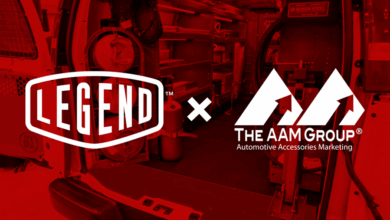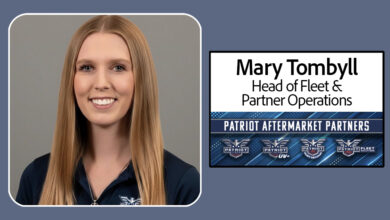Serving the Fleet Vehicle Market
Commercial vehicle upfitting offers chances to boost efficiency & safety...

This article originally appeared in the October 2024 issue of THE SHOP magazine.
By Chris Johnston
Fleet operations are crucial for the everyday success of companies in the mobile maintenance and service industries that maintain and repair vehicles and equipment on the road or at a customer location.
With the need to reduce operating costs, vehicle upfitting—tailoring vehicles to meet specific functional needs—is an essential strategy for companies that want to enhance their fleet performance.
As expert upfitters, specialty aftermarket shops can look to partner with maintenance and service peers to boost operational efficiency and safety for fleet customers.
MEETING FLEET NEEDS
Upfitting standardizes vehicles across fleets, equipping them with uniform features and equipment. This uniformity simplifies operations, facilitates training and makes maintenance more manageable. It can lead to cost reductions and enhance the overall management of the fleet.
Safety enhancements are among the most significant benefits of upfitting. Advanced safety features such as back-up cameras, improved lighting and collision avoidance systems can protect drivers and reduce accident rates, especially on a busy jobsite.
These upgrades are crucial for safety and help minimize the company’s liability risks.
KEY CONSIDERATIONS FOR FLEETS
The process starts with the client selecting the appropriate vehicles based on size, payload capacity, fuel efficiency and maneuverability. Each vehicle should be viewed as a tool designed for specific tasks, ensuring drivers have the right equipment to execute their jobs effectively.
Upfitting must comply with current safety regulations and industry standards. As an industry service provider, Merchants Fleet is up to date on these standards and can integrate essential safety features into vehicles that are upfitted for a company if questions arise.
A commitment to safety helps minimize the risk of accidents and enhances the welfare of the workforce.

VEHICLE DESIGN & OPERATIONAL SUCCESS
The design of fleet vehicles, including considerations like vehicle weight, significantly impacts their operational efficiency.
Managing vehicle weight optimizes fuel efficiency, maximizes payload capacity and improves handling and performance. It also ensures compliance with regulations and reduces maintenance costs by minimizing wear and tear.
UPFITTING ESSENTIALS
There are many things to consider when upfitting a vehicle for use in mobile maintenance. This includes modifications designed to enhance functionality, safety and efficiency.
Here are some items that may be included when upfitting:
Storage Solutions
- Toolboxes: Secure and weather-resistant units for storing hand and power tools.
- Shelving Units: Custom configurations to efficiently organize materials and tools.
- Rack Systems: Used for transporting larger equipment.
Safety Features:
- Beacon Lights: Enhance visibility on the road or at a jobsite, especially in poor lighting conditions.
- Back-up Alarms: Alert others when the vehicle reverses, crucial for preventing accidents.
- Safety Partitions: Installed between the cab and cargo area to protect occupants from shifting loads during transport.
Heavy-Duty Upgrades:
- Heavy-Duty Suspension: Reinforced to support additional weight from equipment and supplies.
- Reinforced Tires: Puncture-resistant with the proper load rating and designed for rough terrains.
- Engine Upgrades: Enhanced cooling systems and larger engine sizes can be considered for vehicles used for heavy loads or those needing added towing capacity.
Power & Electrical Modifications:
- External Power Outlets: Facilitate using electrical tools without additional power sources.
- Upgraded Electrical Systems: Supports additional lighting and electronic equipment.
Exterior & Interior Modifications:
- Towing Packages: Includes hitch receivers and trailer wiring for towing.
- Utility Racks: For transporting bulky or oversized items.
- Durable Floor Linings: Protect the interior from damage and make cleaning easier.
- Ergonomic Seating: Supports long hours of driving or operation with enhanced comfort.
- Custom Paint or Graphics: To include company branding and enhance visibility.
Communication & Navigation Systems:
- GPS Tracking: This is for efficient fleet management and navigation to jobsites.
- Mobile Communication Systems: Include two-way radios or cellular boosters for improved communication in varied environments.
Custom Tailoring for Specific Needs:
- Crane & Winch Systems: For lifting and moving heavy materials.
- Compressed Air Systems: Integrated compressors for powering pneumatic tools.
Choosing durable materials for upfitting components ensures that they can endure daily operations and adverse conditions, extending the vehicle’s lifespan and reducing the frequency and costs of maintenance.

EMERGING TRENDS & TECHNOLOGIES
The integration of telematics with upfitting solutions is transforming fleet management.
Real-time data from GPS tracking, sensors and onboard diagnostics provide insights that enable route optimization, predictive maintenance and enhanced driver performance monitoring.
OVERCOMING COMMON CHALLENGES
Effective cost management is crucial when upfitting vehicles used for mobile maintenance. Despite the initial investment required, employing strategies such as doing research to identify cost-effective upfitting solutions can help manage expenses without compromising safety or quality.
Additionally, reducing downtime is another critical consideration. Planning the upfitting work during off-peak hours or aligning it with scheduled maintenance can significantly reduce operational disruptions.
Merchants Fleet works with customers to streamline and expedite the process, further reducing downtime and ensuring that vehicles are back in service as quickly as possible.
THE ROLE OF DATA
Data and analytics play a crucial role in optimizing the upfitting process. By analyzing vehicle performance data and market trends, fleet managers can make informed decisions that improve efficiency and productivity.
This data-driven approach allows for continual adjustments and enhancements to fleet strategies. Work with your customers on the best decisions for their unique circumstances.
THE FUTURE OF VEHICLE UPFITTING
Integrating advanced technologies like artificial intelligence (AI) and automation will further revolutionize vehicle upfitting. Innovations in smart sensors and autonomous capabilities will enhance monitoring, maintenance and efficiency, paving the way for more innovative, safer and cost-effective fleet operations.
In conclusion, vehicle upfitting is essential to help mobile maintenance companies maximize their performance and reliability. By embracing new technologies, prioritizing safety and utilizing data analytics, fleet managers can ensure their fleets are equipped to meet today’s challenges and are prepared for the future.
Aftermarket shops can be the professional partners they need to ensure efficiency and safety are top priorities.
Chris Johnston is fleet operations manager, short term vehicle ordering, for Merchants Fleet, which has been providing highly customized fleet management and fleet leasing solutions for more than 60 years. Learn more at merchantsfleet.com.



